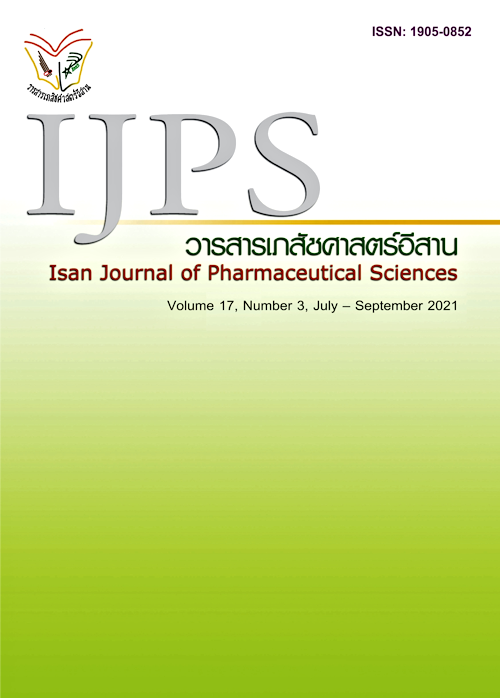Analysis of Fatty Acid Composition, Antioxidant Activity and Cytotoxicity against AGS Human Gastric Adenocarcinoma Cells of Watermelon Seed Oil
Main Article Content
Abstract
Watermelon, Kinnaree variety, is a popular fruit in Thailand due to the feeling of freshness after consuming. The Kinnaree watermelon seeds are inedible parts and considered as waste from watermelon processing industry. However, the watermelon seeds are rich in beneficial oil. And the effects of watermelon seed oil on cytotoxicity against gastric cancer cells have not been reported. Methods: The watermelon seed oil extraction methods was optimized. Fatty acid composition was evaluated by gas chromatography. Antioxidant activities were determined by 2-2′-diphenyl-1-picrylhydrazyl (DPPH) and 2,2’-azino-bis(3-ethylbenzothiazoline-6-sulfonic acid) (ABTS·+) radical scavenging activities. And cytotoxicity against gastric cancer cells (AGS cells) was investigated by 3,(4,5-dimethylthiazol-2-yl)-2,5-diphenyltetrazolium bromide (MTT) assay. Results: The results showed that the highest percent yield of watermelon seed oil was obtained using hexane extraction. The analysis of fatty acid composition showed eight types of fatty acids: myristic acid, palmitic acid, stearic acid, arachidic acid, palmitoleic acid, oleic acid, linoleic acid, and linolenic acid. Linoleic acid was the most abundant fatty acid in watermelon seed oil, accounting for 11.23 ± 0.59 %(w/w) of dried seed weight. The watermelon seed oil contained DPPH radical scavenging activity with the half maximal inhibitory concentration (IC50) value of 3.11 ± 1.49 mg/mL; while the IC50 against ABTS·+ was higher than 500 mg/mL. Moreover, the watermelon seed oil showed cytotoxicity against AGS cells with the IC50 value of 453.7 ± 5.70 µg/mL after 24 hr of treatment. Conclusion: Kinnaree watermelon seed oil had high linoleic acid content, antioxidant capacity, and the ability to inhibit AGS cells proliferation. However, this study was a preliminary study on the properties of the watermelon seed oil, which might help improving economic value of the watermelon seed in the future.
Article Details
In the case that some parts are used by others The author must Confirm that obtaining permission to use some of the original authors. And must attach evidence That the permission has been included
References
Adetutu A, Olorunnisola OS, Owoade OA. Nutritive values and antioxidant activity of Citrullus lanatus fruit extract. Food Nutr Sci 2015; 6(11): 1056–1064.
Agricultural production information system, Department of Agricultural Extension Ministry of Agricultural and Cooperatives. Crop production report [Online]. 2021 [cited 2021 Jan 15]. Available from: https://production.doae.go.th/service/data-state-location/index.
Atolani O, Omere J, Adewuyi OA. Antioxidant and cytotoxicity effects of seed oils from edible fruits. J Acute Dis 2012; 1(2): 130-134.
Bello HS, Ismail HY, Goje MH, Mangga HK. Antimicrobial activity of Citrullus lanatus (watermelon) seeds on some selected bacteria. J Biotechnol Res 2016; 2(6): 39-43.
Biswas R, Ghosal S, Chattopadhyay A, Datta S. A comprehensive review on watermelon seed oil – an underutilized product. IOSR J Pharm 2017; 7(11): 1-7.
Choi YH. Linoleic acid-induced growth inhibition of human gastric epithelial adenocarcinoma AGS cells is associated with down-regulation of prostaglandin E2 synthesis and telomerase activity. J Cancer Prev 2014; 19(1): 31–38.
Czajkowska A, Gornowicz A, Pawłowska N, Czarnomysy R, Nazaruk J, Szymanowski W, et al. Anticancer effect of a novel octahydropyrazino[2,1-a:5,4-a′]diisoquinoline derivative and its synergistic action with nigella sativa in human gastric cancer cells. BioMed Res Int 2017; 2017: 9153403.
Fitzmaurice C, Global Burden of Disease Cancer Collaboration. Global, regional, and national cancer incidence, mortality, years of life lost, years lived with disability, and disability-adjusted life-years for 29 cancer groups, 1990 to 2016: a systematic analysis for the Global Burden of Disease Study. JAMA Oncol 2018; 4(11): 1553–1568.
Jorge N, da Silva AC, Malacrida CR. Physicochemical characterisation and radical-scavenging activity of Cucurbitaceae seed oils. Nat Prod Res 2015; 29(24): 2313–2317.
Kwon JI, Kim GY, Park KY, Ryu CH, Choi YH. Induction of apoptosis by linoleic acid is associated with the modulation of Bcl-2 family and Fas/FasL system and activation of caspases in AGS human gastric adenocarcinoma cells. J Med Food 2008; 11(1): 1-8.
Madhavi P, Rao M, Vakati K, Rahman H, Eswaraiah MC. Evaluation of anti-inflammatory activity of Citrullus lanatus seed oil by in-vivo and in-vitro models. Int Res J Pharm App Sci 2012; 2(4): 104–108.
Mahla, HR, Rathore SS, Venkatesan K, Sharma R. Analysis of fatty acid methyl esters and oxidative stability of seed purpose watermelon (Citrullus lanatus) genotypes for edible oil. J Food Sci Tech 2018; 55(4): 1552–1561.
Molyneux P. The use of the stable free radical diphenylpicrylhydrazyl (DPPH) for estimating antioxidant activity. Songklanakarin J Sci Technol 2004; 26(2): 211–219.
Ouassor I, Aqil Y, Belmaghraoui W, Hajjaji SE. Characterization of two Moroccan watermelon seeds oil varieties by three different extraction methods. OCL Oils Fat Crop Li 2020; 27: 13.
Petchsomrit A, McDermott MI, Chanroj S, Choksawangkarn W. Watermelon seeds and peels: fatty acid composition and cosmeceutical potential. OCL Oils Fat Crop Li 2020; 27: 54.
Rahmat A, Rosli R, Zain W, Endrini S, Sani HA. Antiproliferative activity of pure lycopene compared to both extracted lycopene and juices from watermelon (Citrullus vulgaris) and papaya (Carica papaya) on human breast and liver cancer cell lines. J Med Sci 2002; 2: 55-58.
Re R, Pellegrini N, Proteggente A, Pannala A, Yang M, Rice-Evans C. Antioxidant activity applying improved ABTS radical cation decolorization assay. Free Radic Biol Med 1999; 26(9-10): 1231–1237.
Sueakham T, Chantaramanee C, Iawsipo P. Anti-proliferative effect of Thai watermelon leaf extracts on cervical and breast cancer cells. NU Int J Sci 2018; 15(1): 89-95.
Thongtha S, Sawai P, Srisook K. A comparative study on antioxidant and nitric oxide-inducing activity of some watermelon cultivars grown in Thailand. Burapha Sci J 2017; 22(special issue): 14-22.
Yurchenko S, Sats A, Poikalainan V, Karus A. Method for determination of fatty acid in bovine colostrum using GC-FID. Food Chem 2016; 212: 117–122.
Ziyada AK, Elhussien SA. Physical and chemical characteristics of Citrullus lanatus var Colocynthoide seed oil. J Phys Sci 2008; 19(2): 69-75.


